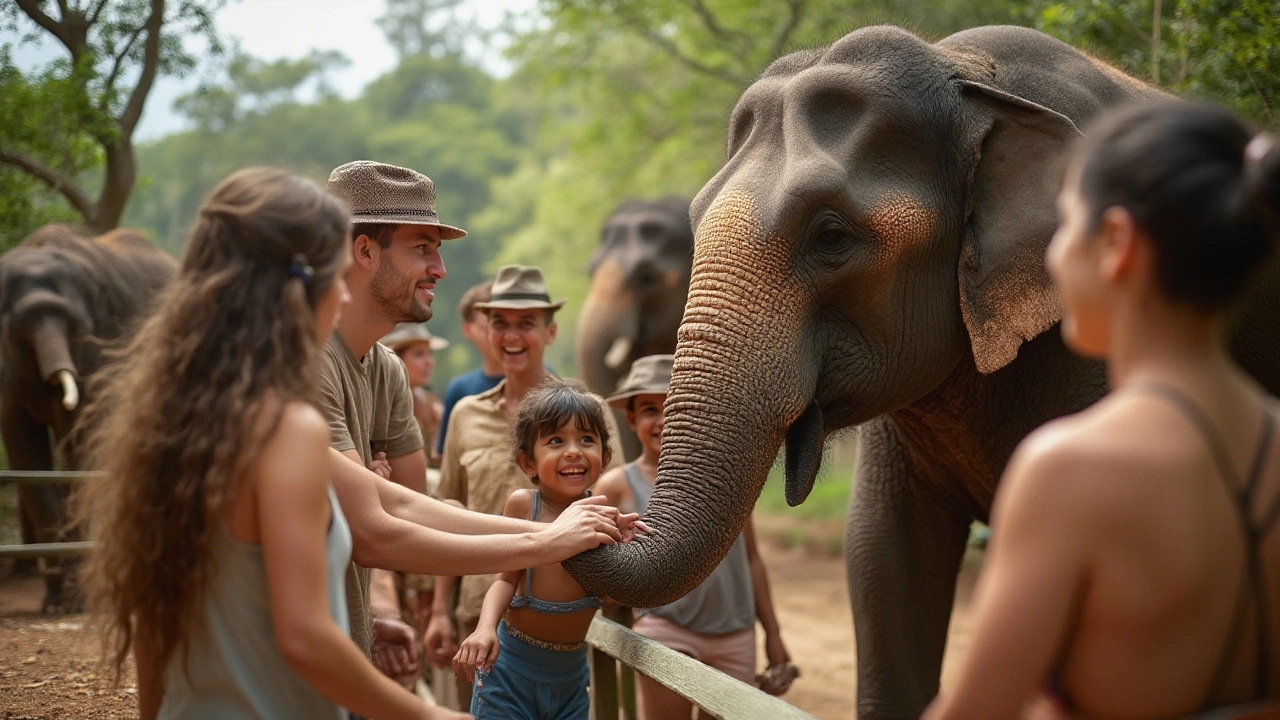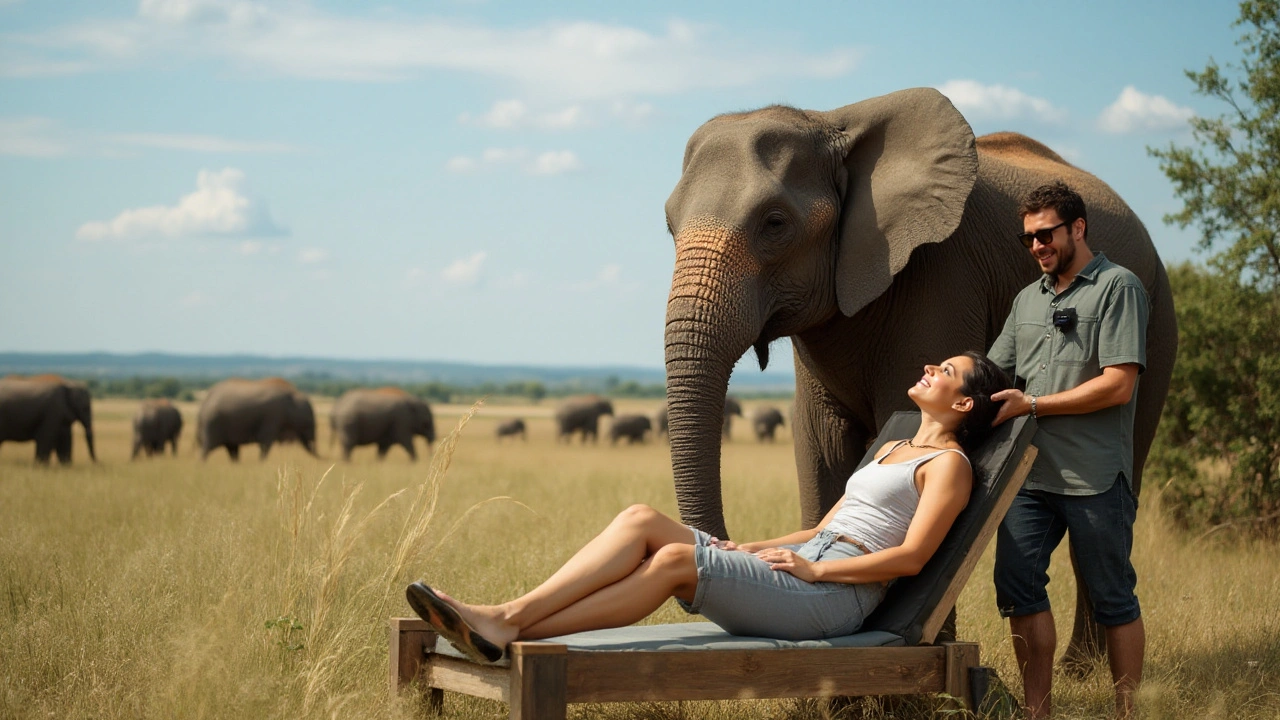Exploring the Surge in Elephant Massage Therapy Popularity
 Oct, 22 2024
Oct, 22 2024
In recent years, a distinctive form of therapy employing the gentle giants of the animal kingdom has captured the global wellness scene's imagination. Elephant massage, a practice inviting the pachyderms to participate in a deeply relaxing experience, is gaining followers with its intriguing blend of nature and nurturing touch.
Originating from countries where elephants have long-standing cultural importance, this massage form not only offers relaxation but helps form an extraordinary bond between humans and these majestic animals. As travelers look for alternative wellness experiences that are both rejuvenating and culturally enriching, the allure of elephant massage therapy stands out.
- Understanding Elephant Massage
- The Origins and Cultural Significance
- Physical Benefits and Techniques
- Mental Health Benefits
- Ethical Considerations
- Tips for Trying Elephant Massage
Understanding Elephant Massage
Elephant massage might sound like an outlandish concept, but it has roots in ancient techniques and traditions. This practice involves trained elephants gently using their trunks and feet to stimulate relaxation and well-being in humans. Primarily found in Thailand and other parts of Southeast Asia, elephant massage has emerged as an alternative therapy that intrigues both locals and tourists alike. Unlike human massage therapists, these massive creatures bring a unique energy and gentle pressure that can create a soothing experience for participants. Professional elephant trainers and handlers, known as mahouts, often supervise these sessions to ensure safety and proper technique.
Historically, elephants have held a place of reverence in various cultures as symbols of strength, wisdom, and loyalty. Their role in therapy may seem new, but the idea of animals aiding in healing is not. People have long turned to creatures as part of therapeutic practices, such as equine therapy or dolphin-assisted therapy. The idea is that interaction with animals can promote emotional well-being and provide support for those seeking a deeper connection with nature. In elephant massage, this connection goes beyond the typical human-animal bond as the elephants become active participants in the healing process.
Sessions usually begin with participants lying on the ground, often over a mat, while the elephant gently taps and caresses using its trunk. The surprisingly subtle and nuanced touch of an elephant's trunk can provide variations of pressure akin to those experienced during a Swedish massage. This form of therapy aims to stimulate circulation, relax muscles, and support overall health. For many, the therapeutic nature of these sessions extends beyond physical touch, offering profound mental health benefits and an unforgettable experience.
While the practice may seem novel, advocates like Somchai Pradit, a renowned Thai wellness expert, praise its unique qualities. "Engaging with such powerful creatures on a personal level brings unparalleled joy and tranquility," he says.
"The harmonious interactions between participants and these pachyderms foster a sense of unity with the earth and its marvelous inhabitants."It's this blend of physical and emotional support that seals elephant massage's place in the expanding world of alternative therapies.
As elephant massage gains traction, the safety of the animals involved and the reputation of service providers are paramount concerns. Not all establishments adhere strictly to ethical standards or prioritize the welfare of both clients and elephants. When considering trying this form of therapy, it is crucial to research and select facilities that are known for humane treatments and positive reviews. Supporting only ethical practices helps ensure these creatures are respected and well-treated, emphasizing the harmony that should define the essence of elephant massage. Keep in mind that the experience is as much about finding balance and tranquility as it is about forming a deeper connection with these marvelous giants.
The Origins and Cultural Significance
The story of elephant massage is deeply rooted in the ancient traditions of regions where elephants roam freely and hold significant cultural value. In places like Thailand, India, and parts of Africa, elephants have been a part of the cultural tapestry for centuries. These majestic creatures are not only seen as beasts of burden but are revered as sacred and symbolic of strength and wisdom. The idea of incorporating elephants into massage therapy is inspired by such traditional connections, where the relationship between humans and elephants extends beyond mere labor to touch the realms of companionship and mutual respect.
The practice is believed to have originated in Thailand, where elephants have played a crucial role in society for years. Historically, they were used in royal ceremonies and even in warfare, functioning as living symbols of power and nobility. As the relationship between humans and elephants evolved, so did the idea of utilizing their gentle touch for therapeutic purposes. This cultural significance adds an emotional and spiritual dimension to elephant massage, transforming it into more than just a novelty but a healing ritual that honors the bond between human and animal worlds.
The Elephant Symbolism
In various cultures, elephants symbolize different virtues, including patience, strength, and wisdom. The Asian tradition, particularly in countries like India and Thailand, holds elephants in high esteem. They are associated with figures like Ganesh, the beloved elephant-headed deity worshipped as a remover of obstacles. Such cultural relevance makes engaging with elephants a deep and meaningful experience; it's not just about getting a massage but connecting with a revered piece of living heritage.
Additionally, the cultural impact extends to local economies and tourism. As people from around the world seek unique travel experiences, elephant massage offers something authentic and spiritually engaging. This form of therapy is often promoted as part of eco-tourism packages, which support conservation efforts and provide alternative livelihoods for communities involved in elephant care. Responsible tourism thus becomes a critical factor, allowing people to enjoy these massages while contributing to preserving the elephant's well-being.
According to a report by the Thai Elephant Conservation Center, "raising awareness about the cultural and ecological importance of elephants helps in sustainable conservation efforts."
Embracing this therapeutic practice can be both enlightening and educational, inviting individuals to appreciate the intricate dance of tradition, culture, and nature. Engaging in elephant massage means exploring a path where ancient practices meet modern wellness, offering insight into not just the human body, but the intricate bond shared with these extraordinary creatures.

Physical Benefits and Techniques
The rise of elephant massage highlights its growing appeal in the wellness community, thanks to the truly unique physical benefits it offers. Imagine a giant yet gentle animal, with its intuitive trunk, applying carefully gauged pressure as it moves across the body – this is the essence of elephant massage. The elephant’s trunk is a sophisticated appendage; it combines strength, precision, and sensitivity, making it a surprisingly adept tool for massage.
Practitioners and enthusiasts who have experienced elephant massage observe that it aids in relieving muscle tension. As the elephant uses its trunk, which can weigh over 300 pounds, to massage, it is capable of delivering deep tissue pressure where needed. This pressure can alleviate knots and stiffness that often plague the human body, especially those in hard-to-reach areas.
One key benefit reported is improved circulation. The rhythmic motions executed by the elephant stimulate blood flow, akin to the benefits derived from traditional human massages. Enhanced circulation leads to faster recovery post-exertion, thus making it a preferred choice for adventurers and athletes. Patrons often find themselves with renewed energy levels after a session.
Practical Techniques Employed
The techniques in an elephant massage session transform a typical day into an unforgettable experience. The animals are expertly trained to use varying pressure levels for different body parts – light brushes for relaxation, and more focused pressure for deeper therapy. This intuitive understanding and responsiveness stem from the elephants’ keen sense of touch and well-trained obedience to their handlers.
In many sessions, the proceedings often begin with the elephant approaching the individual who lies down on a mattress or special mat. Using its trunk, the elephant sweeps gently from the legs to the shoulders in long, soothing motions. This engages large muscle groups and often induces an immediate sense of calm and well-being. Observers often marvel at the precision with which elephants can target specific areas of tension.
According to Dr. Emily Thompson, a renowned zoologist, "The elephant's trunk is a marvel in efficiency, capable of identifying and easing muscle tension in ways that rival the best human practitioners."
As more people seek the healing touch of elephant massage, these gentle giants continue providing not only physical benefits but also create a soulful connection, turning the therapy into a profound, holistic journey. Participants often leave with a story rich in sensory and emotional layers, a testament to these incredible creatures’ capability to nurture and heal.
Mental Health Benefits
Engaging with elephants in a therapeutic setting provides a unique opportunity for mental rejuvenation. Spending time with these tranquil creatures offers a profound sense of calmness, largely due to the serene and grounding presence that elephants naturally exude. Their slow-paced movements and gentle interaction often have a meditative effect that helps ease anxiety and stress, making the experience akin to being deeply immersed in nature's soothing ambiance.
Many people who have experienced this form of therapy describe a deep sense of emotional connection. The act of an elephant gently placing its trunk upon you carries unexpected comfort. This physical interaction encourages a break from the constant mental chatter, allowing one to be fully present in the moment. Therapists emphasize that being around elephants can help trigger the release of endorphins and other feel-good hormones, increasing happiness and reducing stress levels significantly.
Moreover, the element of unpredictability and genuine interaction with elephants can stimulate one's empathy and awareness, broadening the mental scope to appreciate life's subtleties. For those struggling with mental blocks, this encounter can represent the freedom and immense strength these magnificent creatures embody, often inspiring individuals to overcome their personal hurdles with renewed vigor.
"The quiet bond formed between humans and elephants during therapy sessions can lead to emotional breakthroughs and a profound sense of peace," notes Dr. Emily Martin, a renowned psychologist specializing in animal-assisted therapy.
Recent studies have shown a correlation between spending time with animals and improved mental wellness. In a survey conducted among participants who experienced elephant massage, 85% reported feeling calmer and more focused for several days post-session. Although the research on this unique therapy form is still burgeoning, anecdotal evidence continues to highlight its promising potential in mental health improvement.
On another note, the experience contributes to the cultivation of mindfulness. Participants often describe heightened senses and awareness as they attune themselves to the subtle nuances of the elephant's presence. This sensory engagement can lead to enhanced concentration levels and better stress management in daily life. The ability to remain mindful in the face of modern life's challenges is a benefit many seek, making elephant massage not just about physical relief, but a holistic approach to well-being.

Ethical Considerations
As the popularity of elephant massage grows, it's crucial to pause and reflect on the ethical implications of involving such gentle giants in therapy. These animals, revered in many cultures, deserve respect and careful consideration regarding their well-being when performing as part of wellness experiences. The debate about using animals in therapeutic practices centers around their treatment and living conditions. Are these elephants truly leading lives aligned with their natural behaviors, or are they being exploited for human leisure? Such questions warrant deep reflection.
One of the primary concerns is the training process that these elephants undergo. Ethical wildlife tourism advocates for the use of positive reinforcement rather than coercive methods which can cause harm. In environments where elephants are coerced or kept in inadequate conditions, there is a risk of physical and psychological distress. It's crucial to support establishments that prioritize the animals' welfare over profit. Some sanctuaries and wellness centers have developed guidelines ensuring that elephants are not overworked and have adequate space and social structure that mimics their natural habitat.
Another key consideration is the oversight and regulation of the facilities offering these experiences. In countries with limited wildlife protection laws, it's essential for tourists and wellness enthusiasts to do their homework. Responsible tourism demands that we critically engage with the places we visit to ensure they align with ethical practices. Facilities should be transparent about their practices and open to scrutiny from animal welfare organizations. According to 'World Animal Protection', tourists should avoid venues where elephants are in chains or forced to perform unnatural behaviors.
"A truly ethical interaction is one where both humans and animals benefit without compromise to the animal's integrity," says Jane Collins, a spokesperson for the Global Animal Welfare Coalition.
The impact of elephant massage on the mental health of the elephants can also be considered. Much like humans, elephants thrive in environments where they feel safe and unthreatened. Stress from inadequate living conditions or excessive human interaction could negatively impact their well-being. Therefore, it's paramount that they are only exposed to human contact in line with what they are comfortable with. Visitors should be educated about respecting the animal's space and informed consent should be emphasized, even in animals, as feasible. Educating participants on appropriate behavior during such sessions is essential to ensure the safety and comfort of both parties involved.
From a broader perspective, it's vital to engage with the local communities who have lived alongside these majestic creatures for generations. Often, these areas face economic challenges and depend on tourism as a primary income source. Supporting initiatives that provide locals with sustainable economic benefits, without compromising elephant welfare, can forge a more ethical path forward. Therefore, if you are considering trying out an elephant massage, it might be worth researching establishments run by locals who have a vested interest in their long-term sustainability.
Tips for Trying Elephant Massage
Deciding to embark on an elephant massage experience can be both thrilling and rewarding. However, there are a few points to consider before you dive headfirst into this unique therapy. Firstly, understanding the ethical practices of any facility offering elephant massages is crucial. You want to ensure the well-being of these majestic creatures is held in high regard. Many reputable centers prioritize the welfare of their elephants, often including conservation and education as part of their mission. Research these establishments thoroughly, looking for reviews or endorsements from animal welfare organizations, to ensure that your visit supports responsible tourism and enhances your experience without exploiting the animals involved.
Another key consideration when prepping for an elephant massage is understanding your personal comfort level and health requirements. Engaging in an activity involving such large creatures can elicit a wide range of emotional responses. Some find it exhilarating, while others may feel apprehensive. Speak candidly with the facilitators about any concerns you might have; they are usually well-prepared to guide first-timers through the process. Moreover, disclosing any physical ailments or limitations in advance can help tailor the session to better meet your comfort needs. After all, the aim is to revel in relaxation and wellness, not to push boundaries that might lead to discomfort.
When preparing for your session, consider what to wear and pack to maximize comfort and convenience. Opt for loose, breathable clothing that allows for easy movement—something you'd typically wear for a yoga session or casual wellness retreat. This type of therapy, often performed outdoors, might involve sitting or lying on the ground, so a change of clothing could come in handy. Likewise, hygiene essentials like moist towelettes and a water bottle are practical additions to your gear. Staying hydrated will not only keep you comfortable during your session but will help extend its soothing effects.
It's also insightful to enter the session with an appreciation of the potential mental health benefits of an elephant massage. Beyond physical relaxation, spending time with these magnificent animals can significantly boost your emotional well-being. Their calming presence and methodical movements encourage mindfulness and relaxation, gently easing stress and anxiety. For those skeptical about non-traditional therapies, consider what the renowned psychologist Dr. Emily Hartley observed during her research on animal-assisted therapies:
'The rhythm and presence of large animals can have grounding effects on the human psyche, making therapies involving them exceptionally effective in reducing stress.'Keeping an open mind allows you to experience and appreciate the holistic benefits offered by this one-of-a-kind interaction.
If logistics permit, immersing yourself more deeply in the culture around the practice can enhance the richness of your experience. Many locations offering elephant massage are embedded in environments ripe with history and tradition. Taking the time to learn about local customs, traditional healing practices, and the cultural significance of elephants can deepen your connection and understanding of the therapy. Facilities may offer guided tours or workshops that provide insights into the life and habitat of these creatures, making your visit both educational and memorable. Such knowledge enriches your experience, offering you a broader perspective on the intersection of wellness and wildlife conservation.
